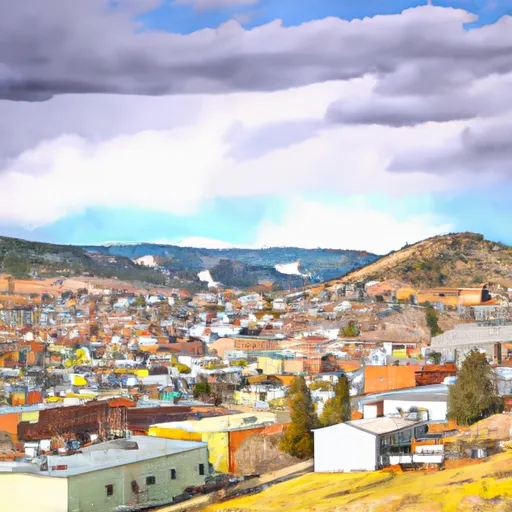-
 Snoflo Premium
Snoflo Premium
Get unlimited access to all our content
With no Ad interruptions! - Start Your Free Trial Login with existing account
Victor
Eden Index
Climate
6.0
•
Recreation
8.0
•
Community
•
Safeguard
5.2/10

Victor, Colorado is a small town located in Teller County, in the central part of the state. Situated at an elevation of around 9,700 feet, the town experiences a high alpine climate with cool summers and cold winters. Summers are mild with average temperatures ranging from the 60s to 70s Fahrenheit, while winters are cold with temperatures often dropping below freezing, accompanied by substantial snowfall.
Hydrologically, Victor is part of the Arkansas River Basin. The area is surrounded by numerous streams and creeks that contribute to the hydrological makeup of the region. These water bodies serve as important sources for irrigation, wildlife habitats, and recreational activities such as fishing and kayaking.
For outdoor enthusiasts, Victor offers several opportunities for recreation. The town is nestled amidst the beautiful Rocky Mountains, providing ample opportunities for hiking, camping, and wildlife viewing. The nearby Pike National Forest offers stunning landscapes and numerous trails for hiking, mountain biking, and horseback riding. Additionally, the area's high elevation makes it a popular destination for winter sports enthusiasts, with opportunities for skiing, snowboarding, and snowmobiling in the nearby resorts.
Overall, Victor, Colorado offers a unique alpine climate, diverse hydrological constituents, and a range of outdoor recreation opportunities, making it an appealing destination for nature lovers and adventure seekers.
What is the Eden Index?
The Snoflo Eden Index serves as a comprehensive rating system for regions, evaluating their desirability through a holistic assessment of climate health, outdoor recreation opportunities, and natural disaster risk, acknowledging the profound impact of these factors on livability and well-being.
Climate Health Indicator (CHI): 6.0
Victor receives approximately
494mm of rain per year,
with humidity levels near 74%
and air temperatures averaging around
3°C.
Victor has a plant hardyness factor of
5, meaning
plants and agriculture in this region thrive during a short period during spring and early summer. Most
plants will die off during the colder winter months.
By considering the ideal temperature range, reliable water supplies, clean air, and stable seasonal rain or snowpacks, the Climate Health Indicator (CHI) underscores the significance of a healthy climate as the foundation for quality living.
A healthy climate is paramount for ensuring a high quality of life and livability in a region, fostering both physical well-being and environmental harmony. This can be characterized by ideal temperatures, reliable access to water supplies, clean air, and consistent seasonal rain or snowpacks.
Weather Forecast
Streamflow Conditions
Upper Arkansas
Area Rivers
Upper Arkansas
Snowpack Depths
Upper Arkansas
Reservoir Storage Capacity
Upper Arkansas
Groundwater Levels
Recreational Opportunity Index (ROI): 8.0
The Recreational Opportunity Index (ROI) recognizes the value of outdoor recreational options, such as parks, hiking trails, camping sites, and fishing spots, while acknowledging that climate plays a pivotal role in ensuring the comfort and consistency of these experiences.
Access to outdoor recreational opportunities, encompassing activities such as parks, hiking, camping, and fishing, is crucial for overall well-being, and the climate plays a pivotal role in enabling and enhancing these experiences, ensuring that individuals can engage in nature-based activities comfortably and consistently.
Camping Areas
| Campground | Campsites | Reservations | Toilets | Showers | Elevation |
|---|---|---|---|---|---|
| Springdale | 13 | 9,304 ft | |||
| Farish Military - USAF Academy | None | 9,083 ft | |||
| The Crags | 17 | 10,120 ft | |||
| Mueller State Park | 90 | 9,313 ft | |||
| Wildhorn | 9 | 8,856 ft | |||
| South Meadows | 64 | 7,897 ft | |||
| Meadow Ridge | 19 | 9,177 ft | |||
| Thunder Ridge | 21 | 9,216 ft | |||
| Painted Rocks | 18 | 7,836 ft | |||
| Colorado | 81 | 7,806 ft |
Nearby Ski Areas
Catastrophe Safeguard Index (CSI):
The Catastrophe Safeguard Index (CSI) recognizes that natural disaster risk, encompassing floods, fires, hurricanes, and tornadoes, can drastically affect safety and the overall appeal of an area.
The level of natural disaster risk in a region significantly affects safety and the overall livability, with climate change amplifying these risks by potentially increasing the frequency and intensity of events like floods, fires, hurricanes, and tornadoes, thereby posing substantial challenges to community resilience and well-being.
Community Resilience Indicator (CRI):
The Community Resilience Indicator (CRI) recognizes that education, healthcare, and socioeconomics are crucial to the well-being of a region. The CRI acknowledges the profound impact of these elements on residents' overall quality of life. By evaluating educational resources, healthcare accessibility, and economic inclusivity, the index captures the essential aspects that contribute to a thriving community, fostering resident satisfaction, equity, and social cohesion.

